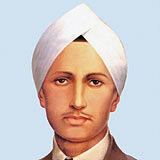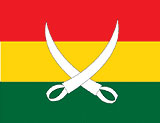|
Kartar Singh had passed his matriculation before leaving the country. He had a revolutionary temperament from the very childhood. A study of his life at school shows that he thought very differently from his classmates. He led his class-fellows in sports. He organized school children against the wrongful acts of the teachers. In 1912 he landed at the port of San Francisco in California and joined many of his compatriots in taking up work in the countryside of California as a farm laborer. There he came face to face with the exploitative attitude of the American farmers and the scorn of the average American worker for Indians. He soon realized that slavery was the biggest curse heaved upon a nation. He exchanged views with his countrymen. The scornful attitude of Americans had opened the eyes of Indians who could no longer tolerate satirical vibes addressed to them. Kartar Singh came across many other Indians who shared his views. He collected them together and organized a meeting in w6ich Lala Har Dayal, Pandit Jagat Ram Rihana, Bhal Jawala Singh and many Indian students and workers participated. They deliberated on the causes of continued enslavement of India. It was felt that a very strong organization was necessary to lead and carry on the battle for liberation. This meeting of minds was a prelude to the creation of the organization but it could not carry out any agenda on its own.
| During this period, Indian workers in the factories of Oregon and Washington states had raised their levels of consciousness to a level where they laid the foundations of an organization. The Ghadar Party was founded in March 1913 in Astoria in the state of Washington. Kartar Singh was beside himself with joy on hearing the news of the launching of the organization. He joined the party immediately.
The Ghadar, newspaper which made its appearance on 1st of November, 1913 owed a lotto his efforts. The newspaper was printed on a hand-operated machine and Kartar Singh not only wrote the Punjabi text but also operated the machine. With the increase of work, many other comrades came to the headquarters. Kartar Singh was ever eager to lend his helping hand to every one. He tried to keep all in good
humour. Like a true revolutionary, he had completely overcome his ego and had dedicated his life in the service of the country. |

Kartar
Singh Sarabha |
Sarabha-Hero of Gadar Movement
There are thousands of known and unknown names who sacrificed their lives for the freedom of India.in various ways worked in the freedom struggle of India. Some people believed in non-violence and some believed in armed struggle. But their aim was one, to free Mother-India from the clutches of British.
Before Mahatma Gandhi, Baba Ram Singh had launched the non-co-operation movement which was called Namdhari movement or Kooka Movement. After that it was the Gadar movement which shook the throne of the British Queen.
Because India was a colony of British and there was no one to raise a voice against such discrimination. Indians felt the necessity of their own government that was not possible without freedom. Kartar Singh Sarabha soon joined the party and sacrificed everything for freedom of his country.
Sarabha was born to Sahib Kaur wife of Sardar Mangal Singh of Sarabha village on May 24, 1896. His father died when he was just an infant. It was his grandfather Sardar Bachan Singh who took care of him. He got his primary education from his village school. He passed middle class from Malwa Khalsa High School, Ludhiana and completed his matriculation form Mission High School. After that he stayed with uncle, Vir Singh in Cuttack, Odisha who was a doctor. But his grandfather sent him to America to get higher education. He took admission at the University of Berkeley and studied chemistry. Around the same time Gadar party was formed and he joined the Indian freedom struggle.
Kartar Singh Sarabha had a key role in writing, editing and publishing work of Gadar (newspaper). He, Lala Hardayal and Raghubar Dayal Gupta were three key members of the press.
Catayltic Efforts
 The Ghadar Party was initially formed by representatives of Oregon and Washington. Californian comrades joined later on. Kartar Singh Sarabha was catalytic in bringing the Californians also into the fold of the party., A conference of representatives of Oregon, Washington and California was held at Stockton in California in February, 1914 which resulted in the formal representation of California in the Ghadar Party. This influx gave added vigour to the Ghadar movement and the party gained tremendous strength.
The Ghadar Party was initially formed by representatives of Oregon and Washington. Californian comrades joined later on. Kartar Singh Sarabha was catalytic in bringing the Californians also into the fold of the party., A conference of representatives of Oregon, Washington and California was held at Stockton in California in February, 1914 which resulted in the formal representation of California in the Ghadar Party. This influx gave added vigour to the Ghadar movement and the party gained tremendous strength.
As soon as the first world. war started, a war counsel was held by Indians in Sacramento to raise the banner of revolt against the British. Kartar Singh played a key role and when the party asked for volunteers to learn flying, he was the first to offer his name and was selected also.
When the party decided to ask its members to leave for India to work forthe revolution, Kartar Singh was in the first batch who boarded the ship for India. He did not come alone but brought along three American revolutionaries who were his friends. Two of them were men and one was a woman.
He was adept in adopting disguises. He entered India through Colombo and evaded the eagle eye of the police and reached India and engaged himself in revolutionary work.
He met Shachinder Narth Sanyal and Rash Behari Bose through Mr. Pingley. He moved about freely outside Punjab in the company of Pingley and Sanyal. He would enter the army establishments very casually and propagate rebellion. He was successful in converting the sepoys of Qiia Ferozepur for ramapaging the magazine.
On the advice of Rash Behari Bose and incitement of Nawab Khan he agreed to committing dacoities. And thereafter there was no such action in which he did not participate. Even while
committing dac6ities, he was forthright in speaking of his mission. He would tell the affected that since there was no other source of money and it was
necessary to throw out the British, they were compelled to do such acts and he promised that after liberation all the money now looted would be returned with interest. He had exemplary moral character. During the dacoity at Sahnewal, a member of the gang cast an evil eye on a beautiful girl. Sarabha immediately placed his revolver on the chest of the culprit and forced him to offer apology for his conduct. After the failure of the revolution-, the members who had escaped arrest decided to leave India. Kartar Singh, Hamam Singh Tunditat, Jagat Singh etc. were asked to go to Afghanistan and they did make a move towards that area. But his conscience did not permit him to run away when all his cororades had been held. He came back with two friends and went over to Chak No. 5 in Sargodha where there was a military stud and started propagating rebellion amongst the
army men. A Risaidar got him and his friends arrested.
CID officers like Mr. Tomkin were rather afraid of interrogating him. He was a fearless and unrelenting
young man, devoted to the cause of independence and a sworn enemy of slavery.
When he was an under trial in Lahore Central Jail, he made an abortive attempt to escape. He was caught with saws and other cutting instruments and bomb-making material. But he was as self-assured as ever. He continued to laugh. and make others laugh. He would draw tunes by striking at his fetters and go on singing nationalist songs. When the case came to be heard, we saw simultaneously two courts. The judges held their court and Sarabha held his court joking and laughing away with his friends. The moles and prosecution witnesses were the butt of his humour.
The judges would ring their bells but no one would pay any attention to them.
After the prosecution witnesses had been examined, Kartar Singh Sarabha was asked to make his statement. He accepted his role in the movement and proudly proclaimed that whatever he did, he did with a sense of responsibility. He considered it his
duty to rouse the people against British slavery. And his calling the army to rebel, preparing national flags and performing other revolutionary acts were towards fulfilment of his inalienable birth right to see India independent and free. On recording his evidence, the Judges remarked: "Kartar Singh, do you know where your confession is going to lead you to?" Kartar Singh replied that he knew his fate. He could be hanged or transported for life. The judge gave him time and asked him to think overnight. The next day again, Kartar Singh stuck to his statement and
toid the judges that he stood bye very word he had said earlier.
When the sentence of death was pronounced on Kartar Singh, he laughed and said in a loud voice: "Thank you". After the pronouncement of the death sentence, Kartar Singh and his, friends were sent to the condemned cells and were dressed in the uniform of condemned prisoners, the Jail Superintendent went to him. In pursuance of legal stipulations, he asked Kartar Singh if he wanted to make a mercy petition. Kartar Singh replied that he was not interested in a mercy petition but requested for an early execution of the sentence so that he could take rebirth and fight against slavery again.
On 16th November, 1915, the government decision to commute the death sentences of 17, other Ghadarites to transporation Of life was communicated but Kartar Singh and six of his comrades were still condemned to be hanged, he was again asked to make a mercy petiton but his reply was the same. "Execute the sentence immediately". Kartar Singh had lost his father and mother in early childhood. His old grandfather had brought him up. When he came for the fast meeting with Kartar Singh he started weeping. Kartar Singh addressed him "Dadaji, why do you weep? I am not leaving after causing any disgrace to the family. I am being hanged for the crime of working for the liberation of thirty crore suppressed and enslaved people. You should not weep over such a glorious death but celebrate it". The grandfather was overwhelmed by these courageous words coming from the lips of Kartar Singh and gave him his last blessing.
Kartar Singh and six of his comrades were hanged to death in Lahore Central Jail on the morning of 17th November, 1915. He has very few peers in the annals of world history.
|